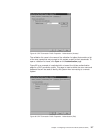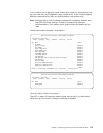v Exchange sign-on and password information to authorize a remote host to
connect to an AS/400
v Select the type of service requested (for example SLIP or PPP) from an ISP
Normally, all of these functions are performed when a PPP connection is negotiated
by AS/400. However, some ISPs may require user authorization or a type of service
selection prior to negotiating the PPP connection. Additionally, you will need to take
into account the following considerations:
v If a connection to or from an AS/400 is authenticated using a connection dialog
script, then the user ID and password that will be used is the one that was
specified in the connection profile for PAP validation. If the remote host does not
support validation when PPP is negotiated, then you
must
deactivate this
selection after you specify the PAP user ID and password.
v Connection validation with CHAP for PPP may also be requested after the initial
authentication. This is accomplished using the connection dialog script with a
different and more secure user ID and password.
v Any dynamic IP addresses that are exchanged during the connection dialog will
not be used by AS/400.
NLS Considerations
Once a SLIP connection is established, the application, such as TELNET or FTP,
that is running over the connection, must manage the ASCII to EBCDIC and
EBCDIC to ASCII translation.
If you are not using a connection script to establish a SLIP connection to or from a
remote system, then no other NLS considerations are necessary. If you are using a
connection script then it may be important to understand how AS/400 translates
connection scripts from EBCDIC to ASCII to be transmitted back and forth over the
connection.
Connection scripts on AS/400 are stored in EBCDIC format. However, most
systems that will connect to AS/400 are probably ASCII systems that will send their
connection script data in ASCII format. Therefore, AS/400 must translate the ASCII
data that is coming in to AS/400 over the connection from ASCII to EBCDIC.
AS/400 can then compare the connection script to the EBCDIC connection script
that is stored on AS/400.
Before AS/400 can send data to a remote system over the SLIP connection, AS/400
must translate the connection script data from EBCDIC to ASCII. The default
EBCDIC and ASCII CCSID values that AS/400 uses to translate connection scripts
are described below. The default values cover most needs, but you can change the
default values if you need support for other characters.
The default connection scripts that are shipped with AS/400 are located in members
in file QUSRSYS/QATOCPPSCR. See “Connection Dialog Scripts” on page 156 for
details on using connection scripts and for the member names.
This default connection script file, QATOCPPSCR, uses a CCSID of 500, which
means character set 697 and code page 500. Therefore, all character data in each
connection script member have a hex code point that this CCSID supports. AS/400
uses the EBCDIC CCSID value to translate connection script data when AS/400
sends the connection script data to or receives the connection script data from a
remote system.
Chapter 4. Configuring Point-to-Point TCP/IP (PPP and SLIP) 125


















